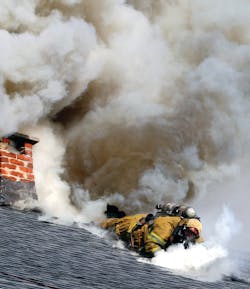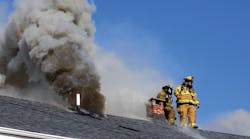“Close Call at Roof Operation”: Avoiding Bad Situations
Your March 2012 cover story, “Close Call at Roof Operation,” infuriated me and should make every member of the fire service grimace. While we are all relieved that the two firefighters made it off the roof alive and not seriously hurt, all of us who have tried to embed safe operations within effective firefighting tactics must insist that we start to distinguish between close calls and bad calls.
A close call is where an adverse development arises from sound operational strategy or tactics. A bad call is where an unsound strategic plan or tactical move results in one or more of a highly predictable set of outcomes. Without this distinction between close calls and bad calls, the efforts of many to evaluate and minimize the dangerous consequences that can arise from close calls will be diminished and we will never get to the root of the problem of making bad calls.
As they say, a picture is worth a thousand words and your generous photo array tells the whole story. Fire in an attic already showing signs of breach with considerable smoke from the roof, soffits and chimney, no ladder egress from the roof (the aerial should have been committed to the roof whether or not it was the original mode of getting to the roof, especially in light of the rapidly deteriorating conditions), poor PPE management (where are the Nomex hoods and chin straps?) and disregard for basic building construction principles all made this a recipe for disaster. A classic bad call, not even a close call.
I use cover pictures and stories like this one in tactical and safety drills to show the what-not-to-do’s as much as raise the situational awareness of firefighters to the what-to-watch-out-fors. It is not to second-guess or armchair quarterback a particular call, but to teach ways to avoid bad situations as well as to respond to the adverse developments of close calls.
The fire service will only take safety to the next level industry-wide if we speak frankly of poor fireground decision making that leads to the guys on the roof type of situations. Professional courtesies notwithstanding, we command officers owe it to all members of the fire service to critically evaluate bad calls as a way to keep our firefighters from the consequences of our bad calls as the close calls are already enough of a hazard to face.
Chief Gregory V. Serio
Verdoy Fire Department
Latham, NY
Being mindful of the fundamentals
I am writing in regard to the cover story in the March issue that covers the close call at a roof operation. I am a rookie firefighter/EMT IV in Tennessee. I recently completed the rookie program at the Tennessee Fire Service and Codes Enforcement Academy and earned my Fire 1 Commission. With my little time in the fire service and my recent training, I noticed some things that bothered me in the article and most of all in the pictures.
I notice both men on the roof with exposed ears and neck that showed the lack of a hood, and their collars are not strapped. I also noticed the absence of tools. Neither man carries a tool. It also shows one of the men has removed his mask and is off air on the roof looking for escape. I was reminded of my training in reading this article and reminded of basic skills. The fundamentals of carrying a tool into a fire, proper donning of PPE (personal protective equipment) and always being on air in an IDLH (immediately dangerous to life or health) atmosphere. I am glad this situation was a success and that no one was seriously injured.
My instructors and mentors who have taught me, and are teaching me, and who deserve the credit are my captain, Glenn Travis of the Covington Fire Department, and Lead Instructors Rob Doremus, Michael Newberry and Jay Bonson and Program Director Wayne Morris at the Tennessee Fire Academy. I work on C shift and the whole C shift crew is instrumental in my skills and emotional support too.
I thoroughly enjoy reading your publication. I look forward to many years in the fire service and also your future publications. Thank you.
Baker McCool
Firefighter/EMT IV
Covington Fire Department
Covington, TN
We welcome feedback, views, reactions and observations. Please send letters to Forum, Firehouse Magazine, 3 Huntington Quadrangle, Suite 301N, Melville, NY 11747; fax them to 631-845-2741; or e-mail them to [email protected]. Letters may be edited for space and clarity. The opinions expressed here are solely those of the undersigned and do not represent endorsement by Firehouse® Magazine.







